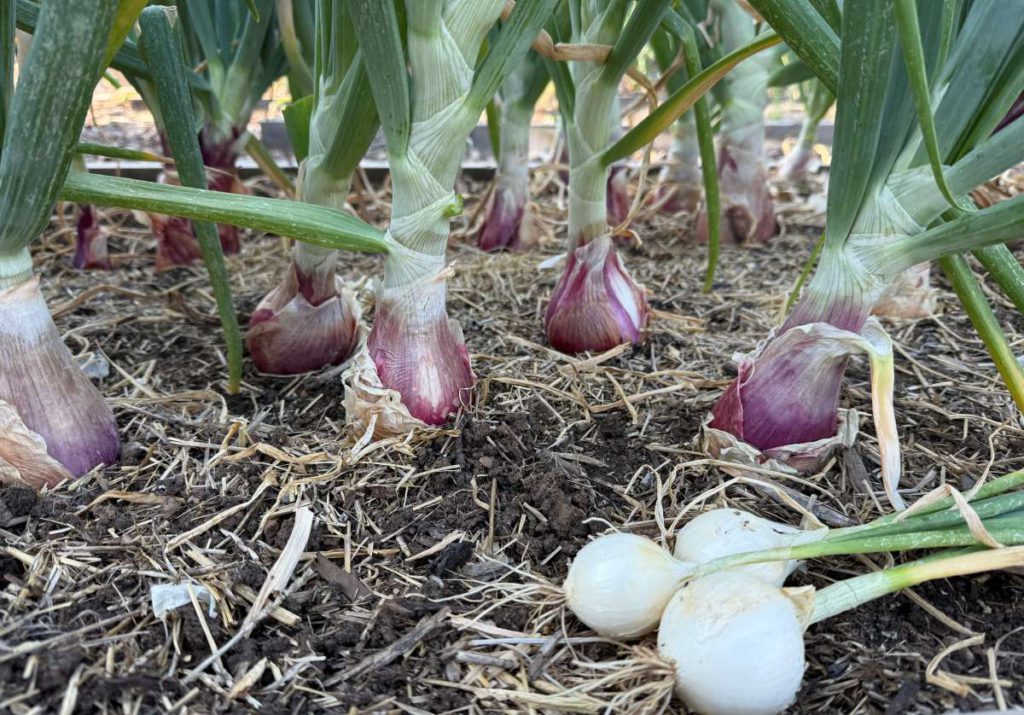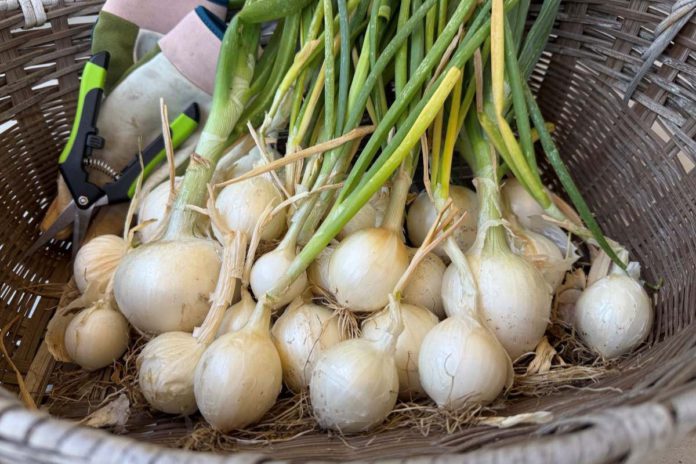Onions are staple crops in my home garden. The taste, high yield, versatility and options for long-term storage make them highly desirable. Another draw for this crop is that it allows me to utilize the not-so-accessible areas of the garden as it does not require much ongoing maintenance and upkeep.
Onions are classified based on taste: strong flavored (also called American), and mild or sweet (European). Generally, American onions have smaller bulbs with denser texture, stronger flavor and better keeping quality than European. Milder ones are generally preferred for fresh consumption while stronger ones are used for cooking.
Another classification is by color. Both American and European onions can be yellow, white and red. Our household likes to eat raw red onions as a side with ethnic meals, white and yellow in sandwiches, and pearl onions for pickling and cocktails. For curries, pastes and tempering we use a mix.
The most important factor for growing onions is the length of available daylight. There are three varieties—short, intermediate, and long day. Long-day onions need 14 or more hours of sunlight before they initiate bulb formation, intermediate onions require about 13-14 hours and short-day onions require about 12 hours.

Onions can be grown from seeds, transplants or sets. Seeds provide the most flexibility, and transplants convenience. Onion sets are grown from seeds in the spring, set so close together that their growth is limited. When planted the following season, they will mature sooner than ones grown from seeds. I prefer not to use onion sets as they have a tendency to flower instead of developing bulbs—also called bolting.
For the Bay Area, intermediate day onions are best. One can plant from September to November, or transplant from January through March for a late summer or fall harvest. I plant onions when I receive a shipment for my area from my vendor, which simplifies timing. If I want to try a new variety, I follow instructions on the seed packet label.
To plant onions, pick a space in your yard that gets full sun. Onions need loose, rich soil that drains well and has been amended with compost or well-rotted manure. Plant onion transplants at four- to eight-inch intervals depending on size, and in rows that are 18 inches apart. Being a home gardener with space limitations, I tend to plant them closer. Since I pick some early to use as green onions, that creates space later in the growing season when bulbs need room to expand.
Onion transplants should be planted about one inch deep with the top of the bulb at or just below the soil surface. Since onions have shallow roots, they need to be watered frequently during the growing season to ensure the soil stays moist. A combination of drip irrigation and hand watering as needed has worked well for me.
Stop watering once leaves start turning yellow and bulbs start rising above the soil. If the soil is rich, a light and infrequent application of fertilizer is sufficient as leaves are growing. Once bulbs begin forming, stop adding fertilizer to prevent bulbs from splitting.
When the top half of onion plants have bent over, stop watering and bend the remainder of the stalk using the back of a rake, making sure the neck does not break. As soon as the bent tops begin to yellow and dry, gently dig, keeping the drying leaves attached and intact.
At this point, the onions can be used fresh, or they can be cured for long term storage. To cure onions, dry them on a wire rack, perforated basket or slotted crate that allows for air flow. Wait until the leaves have completely dried up. Cut the tops, leaving about an inch, and store bulbs in a cool, dry and dark place with good ventilation.
Our family uses onions in many different ways. They can be added to soups, stews, salads, sandwiches, and can be fried, sautéed or caramelized for enhancing the flavor of many dishes.
Onion flatbread or pyaaz paranthi

Whole wheat flour – Two cups, plus one additional cup for dusting
Water – About one cup
Finely diced onions – One cup
Chopped herbs like mint, cilantro, green onions – Half cup
Spices – Red chili flakes, chopped green Thai chili, a pinch of turmeric powder and salt to taste
Oil, butter or ghee – About two tablespoons to cook per flatbread
Oil, or ghee to be mixed in the dough – Two tablespoons
Equipment – Heavy bottom sauce pan or a griddle, rolling pin
Makes six to seven flatbreads
Combine all dry ingredients in a mixing bowl. Make a soft dough using water and let it rest for half an hour. When ready to make the bread, heat the griddle up. Lightly oil your palms and piece out a small lump of dough about the size of a golf ball and roll it into a ball. Sprinkle dry flour on a flat, smooth work surface and flatten dough with a rolling pin. This amount of dough will make a flatbread of about seven inches.
Heat the griddle to medium high, and transfer the rolled-out dough to the griddle. Flip over with a flat spatula after 30 seconds. Cook bread with the fat of your choice for a few minutes on each side until golden brown. The amount of fat in the recipe can be increased, decreased or skipped as desired. Serve with yogurt raita, mint chutney, or mango pickle. My personal favorite is to enjoy it with maple yogurt.
Note: This article gives an overview of growing plants, sun and soil requirements, moisture needs etc. Plant health and growth will vary based on various factors. This article is intended for gardening and culinary inspiration only. Please consult your healthcare provider should you have any questions or concerns about adding any new foods or ingredients to your diet.




